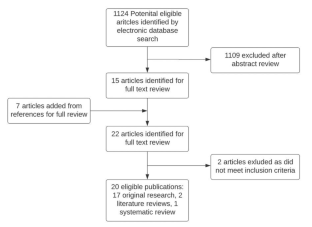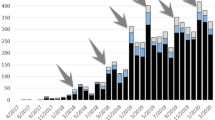Abstract
Purpose
Effective health technology management (HTM) is critical to healthcare delivery worldwide. The absence of proper HTM in low-resource settings leads to a lack of medical equipment that is operational or safe for use. Previous solutions including medical equipment donation have proven ineffective as The World Health Organization estimates that 50–80% of equipment is non-functional. This paper examines the facilitators and barriers to implementing Computerized Maintenance Management Systems (CMMS) as a means of improving HTM in Low-Middle-Income Countries (LMIC).
Methods
Five electronic databases were searched. Original research, literature reviews, and systematic reviews in English were included. Abstracts from all eligible articles were reviewed and, if indicated, the full text was screened. Furthermore, the reference list of included articles was scanned for relevant studies. Articles were analyzed using a ‘constant comparative’ method.
Results
Themes identified include quality improvement, facilitators to CMMS implementation, and barriers to CMMS implementation. Hospitals in resource-limited settings report improvements in their maintenance practices and operational costs following the implementation of CMMS. A centralized internet-accessible server and standardization of training were found to be the main facilitators of CMMS implementation. Major barriers included difficulty retaining trained of trained engineers, the need for continued education, costs, the lack of consumables needed for equipment maintenance, and considerations of local context.
Conclusion
The importance of proper HTM in resource-limited hospital settings cannot be overlooked. The absence of proper HTM can be, in part, attributed to the shortage of skilled engineers. This emphasizes the need for access to continued biomedical engineering education to continue to advance and develop HTM in low resource settings. Although the implementation of CMMS in LMICs presents a multitude of challenges, our review found that it is by no means unfeasible, especially when adequate standardization and local context are taken into consideration.

Similar content being viewed by others
References
Medenou D, Fagbemi LA, Houessouvo RC, et al. Medical devices in Sub-Saharan Africa: optimal assistance via a computerized maintenance management system (CMMS) in Benin. Health Technol. 2019;9:219–32. https://doi.org/10.1007/s12553-018-00283-3.
Ogembo-Kachieng’a M, Ogara WO. Strategic management of technology in public health sector in Kenya and South Africa. East Afr Med J. 2004;81(6):279–86. https://doi.org/10.4314/eamj.v81i6.9176.
Zamzam AH, Abdul Wahab AK, Azizan MM, Satapathy SC, Lai KW, Hasikin K. A systematic review of Medical Equipment Reliability Assessment in improving the quality of Healthcare Services. Front Public Health. 2021;9:753951. https://doi.org/10.3389/fpubh.2021.753951. Published 2021 Sep 27.
WHO. Introduction to medical equipment inventory management. Published 2011. https://www.who.int/publications/i/item/9789241501392 Accessed 22 Nov 2022.
Beniacoub F, Ntwari F, Niyonkuru JP, Nyssen M, Van Bastelaere S. Evaluating a computerized maintenance management system in a low resource setting. Health Technol (Berl). 2021;11(3):655–61. https://doi.org/10.1007/s12553-021-00524-y.
Wilson PT, Brooks JC, Otupiri E, Moresky RT, Morris MC. Aftermath of a clinical trial: evaluating the sustainability of a medical device intervention in Ghana. J Trop Pediatr. 2014;60(1):33–9. https://doi.org/10.1093/tropej/fmt074.
Perry L, Malkin R. Effectiveness of medical equipment donations to improve health systems: how much medical equipment is broken in the developing world? Med Biol Eng Comput. 2011;49(7):719–22. https://doi.org/10.1007/s11517-011-0786-3.
Mavalankar D, Raman P, Dwivedi H, Jain ML. Managing equipment for emergency obstetric care in rural hospitals. Int J Gynaecol Obstet. 2004;87(1):88–97. https://doi.org/10.1016/j.ijgo.2004.07.003.
WHO. The sixtieth world health assembly: Having considered the report on health technologies. WHA60. 29. Published 2007 May 23. Accessed 22 Nov 2022.
Cohen T. Computerized maintenance management systems: how to match your department’s needs with commercially available products. J Clin Eng. 1995;20(6):457–68. https://doi.org/10.1097/00004669-199511000-00008.
WHO. Computerized maintenance management system. Published 2011. https://www.who.int/publications-detail-redirect/9789241501415 Accessed 22 Nov 2022.
Barnett-Page E, Thomas J. Methods for the synthesis of qualitative research: a critical review. BMC Med Res Methodol. 2009;9:59. https://doi.org/10.1186/1471-2288-9-59. Published 2009 Aug 11.
Thomas J, Harden A. Methods for the thematic synthesis of qualitative research in systematic reviews. BMC Med Res Methodol. 2008;8:45. https://doi.org/10.1186/1471-2288-8-45. Published 2008 Jul 10.
Basiony M. Computerized Equipment Management System. J Clin Eng 2013;38(4).
Massambu C, Mwangi C. The Tanzania experience: clinical laboratory testing harmonization and equipment standardization at different levels of a tiered health laboratory system. Am J Clin Pathol. 2009;131(6):861–6. https://doi.org/10.1309/AJCP3ZAAFUPCIXIG.
Veluchamy S. A proposed computer-assisted preventive maintenance system. J Clin Eng. 1982;7(3):245–9. https://doi.org/10.1097/00004669-198207000-00014.
Mutia D, Kihiu J, Maranga S. Maintenance management of Medical Equipment in Hospitals. Industrial Eng Lett. 2012;2(3):9–19.
Cruz AM, Barr C, Denis ER. Offering integrated medical equipment management in an application service provider model. Biomed Instrum Technol. 2007;41(6):479–490. doi:https://doi.org/10.2345/0899-8205(2007)41[479:OIMEMI]2.0.CO;2
Kutor JK, Agede P, Ali RH. Maintenance practice, causes of failure and Risk Assessment of Diagnostic Medical Equipment. J Biomed Eng Med Devic. 2017;2:123.
Marks IH, Thomas H, Bakhet M, et al. Medical equipment donation in low-resource settings: a review of the literature and guidelines for surgery and anaesthesia in low-income and middle-income countries. BMJ Global Health. 2019;4:e001785.
Ademe BW, Tebeje B, Molla A. Availability and utilization of medical devices in Jimma zone hospitals, Southwest Ethiopia: a case study. BMC Health Serv Res. 2016;16:287. https://doi.org/10.1186/s12913-016-1523-2.
Malkin R, Keane A. Evidence-based approach to the maintenance of laboratory and medical equipment in resource-poor settings. Med Biol Eng Comput. 2010;48(7):721–6. https://doi.org/10.1007/s11517-010-0630-1.
Thapa R, Yih A, Chauhan A, et al. Effect of deploying biomedical equipment technician on the functionality of medical equipment in the government hospitals of rural Nepal. Hum Resour Health. 2022;20:21. https://doi.org/10.1186/s12960-022-00719-y.
Penfold S, Shamba D, Hanson C, et al. Staff experiences of providing maternity services in rural southern Tanzania – a focus on equipment, drug and supply issues. BMC Health Serv Res. 2013;13:61. https://doi.org/10.1186/1472-6963-13-61.
Funding
The authors declare that no funds, grants, or other support were received during the preparation of this manuscript.
Author information
Authors and Affiliations
Contributions
All authors contributed to the study conception and design. Material preparation, data collection and analysis were performed by Danielle Cohen and Nikola Visnjic. The first draft of the manuscript was written by Danielle Cohen and all authors commented on previous versions of the manuscript. All authors read and approved the final manuscript.
Corresponding author
Ethics declarations
Competing Interests
The authors have no relevant financial or non-financial interests to disclose.
Ethics approval
This literature review did not require ethics approval.
Consent to participate
This review does not require consent to participate as it only reviews previously published literature.
Consent to publish
This review does not require consent to publish as it only reviews previously published literature.
Additional information
Publisher’s Note
Springer Nature remains neutral with regard to jurisdictional claims in published maps and institutional affiliations.
Rights and permissions
Springer Nature or its licensor (e.g. a society or other partner) holds exclusive rights to this article under a publishing agreement with the author(s) or other rightsholder(s); author self-archiving of the accepted manuscript version of this article is solely governed by the terms of such publishing agreement and applicable law.
About this article
Cite this article
Cohen, D., Visnjic, N., Akaateba, D. et al. Narrative literature review of facilitators and barriers to implementing computerized maintenance management systems in low-middle-income countries. Health Technol. 13, 373–378 (2023). https://doi.org/10.1007/s12553-023-00743-5
Received:
Accepted:
Published:
Issue Date:
DOI: https://doi.org/10.1007/s12553-023-00743-5




